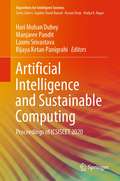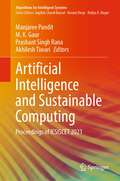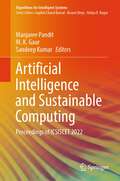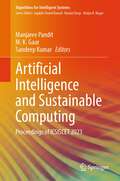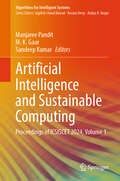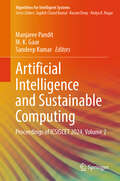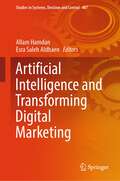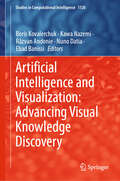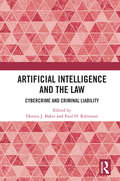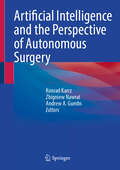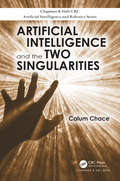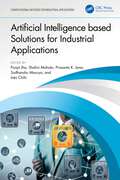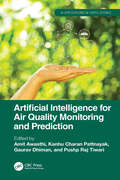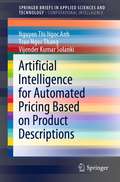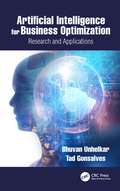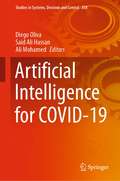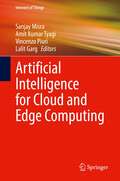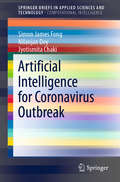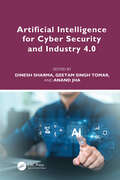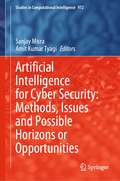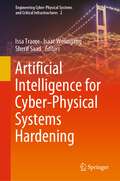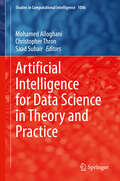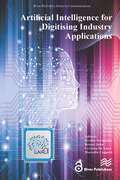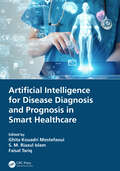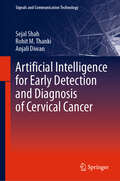- Table View
- List View
Artificial Intelligence and Sustainable Computing: Proceedings of ICSISCET 2020 (Algorithms for Intelligent Systems)
by Bijaya Ketan Panigrahi Manjaree Pandit Laxmi Srivastava Hari Mohan DubeyThis book presents the outcome of two-day 2nd International e-Conference on Sustainable and Innovative Solutions for Current Challenges in Engineering and Technology (ICSISCET 2020) held at Madhav Institute of Technology & Science (MITS), Gwalior, India, from December 18–19, 2020. The book extensively covers recent research in artificial intelligence (AI) that knit together nature-inspired algorithms, evolutionary computing, fuzzy systems, computational intelligence, machine learning, deep learning, etc., which is very useful while dealing with real problems due to their model-free structure, learning ability, and flexible approach. These techniques mimic human thinking and decision-making abilities to produce systems that are intelligent, efficient, cost-effective, and fast. The book provides a friendly and informative treatment of the topics which makes this book an ideal reference for both beginners and experienced researchers.
Artificial Intelligence and Sustainable Computing: Proceedings of ICSISCET 2021 (Algorithms for Intelligent Systems)
by Manjaree Pandit M. K. Gaur Prashant Singh Rana Akhilesh TiwariThis book presents high-quality research papers presented at 3rd International Conference on Sustainable and Innovative Solutions for Current Challenges in Engineering and Technology (ICSISCET 2021) held at Madhav Institute of Technology & Science (MITS), Gwalior, India, from November 13–14, 2021. The book extensively covers recent research in artificial intelligence (AI) that knits together nature-inspired algorithms, evolutionary computing, fuzzy systems, computational intelligence, machine learning, deep learning, etc., which is very useful while dealing with real problems due to their model-free structure, learning ability, and flexible approach. These techniques mimic human thinking and decision-making abilities to produce systems that are intelligent, efficient, cost-effective, and fast. The book provides a friendly and informative treatment of the topics which makes this book an ideal reference for both beginners and experienced researchers.
Artificial Intelligence and Sustainable Computing: Proceedings of ICSISCET 2022 (Algorithms for Intelligent Systems)
by Sandeep Kumar Manjaree Pandit M. K. GaurThis book presents high-quality research papers presented at 4th International Conference on Sustainable and Innovative Solutions for Current Challenges in Engineering and Technology (ICSISCET 2022) held at Madhav Institute of Technology & Science (MITS), Gwalior, India, from November 19 to 20, 2022. The book extensively covers recent research in artificial intelligence (AI) that knit together nature-inspired algorithms, evolutionary computing, fuzzy systems, computational intelligence, machine learning, deep learning, etc., which is very useful while dealing with real problems due to their model-free structure, learning ability, and flexible approach. These techniques mimic human thinking and decision-making abilities to produce systems that are intelligent, efficient, cost-effective, and fast. The book provides a friendly and informative treatment of the topics which makes this book an ideal reference for both beginners and experienced researchers.
Artificial Intelligence and Sustainable Computing: Proceedings of ICSISCET 2023 (Algorithms for Intelligent Systems)
by Sandeep Kumar Manjaree Pandit M. K. GaurThis book presents high-quality research papers presented at the 5th International Conference on Sustainable and Innovative Solutions for Current Challenges in Engineering and Technology (ICSISCET 2023) held at Madhav Institute of Technology & Science (MITS), Gwalior, India, during October 21–22, 2023. The book extensively covers recent research in artificial intelligence (AI) that knit together nature-inspired algorithms, evolutionary computing, fuzzy systems, computational intelligence, machine learning, deep learning, etc., which is very useful while dealing with real problems due to their model-free structure, learning ability, and flexible approach. These techniques mimic human thinking and decision-making abilities to produce systems that are intelligent, efficient, cost-effective, and fast. The book provides a friendly and informative treatment of the topics which makes this book an ideal reference for both beginners and experienced researchers.
Artificial Intelligence and Sustainable Computing: Proceedings of ICSISCET 2024, Volume 1 (Algorithms for Intelligent Systems)
by Sandeep Kumar Manjaree Pandit M. K. GaurThis book presents high-quality research papers presented at the 6th International Conference on Sustainable and Innovative Solutions for Current Challenges in Engineering and Technology (ICSISCET 2024) held at Madhav Institute of Technology & Science (MITS), Gwalior, India, during October 26–27, 2024. The book extensively covers recent research in artificial intelligence (AI) that knit together nature-inspired algorithms, evolutionary computing, fuzzy systems, computational intelligence, machine learning, deep learning, etc., which is very useful while dealing with real problems due to their model-free structure, learning ability, and flexible approach. These techniques mimic human thinking and decision-making abilities to produce systems that are intelligent, efficient, cost-effective, and fast. The book provides a friendly and informative treatment of the topics which makes this book an ideal reference for both beginners and experienced researchers.
Artificial Intelligence and Sustainable Computing: Proceedings of ICSISCET 2024, Volume 2 (Algorithms for Intelligent Systems)
by Sandeep Kumar Manjaree Pandit M. K. GaurThis book presents high-quality research papers presented at the 6th International Conference on Sustainable and Innovative Solutions for Current Challenges in Engineering and Technology (ICSISCET 2024) held at Madhav Institute of Technology & Science (MITS), Gwalior, India, during October 26–27, 2024. The book extensively covers recent research in artificial intelligence (AI) that knit together nature-inspired algorithms, evolutionary computing, fuzzy systems, computational intelligence, machine learning, deep learning, etc., which is very useful while dealing with real problems due to their model-free structure, learning ability, and flexible approach. These techniques mimic human thinking and decision-making abilities to produce systems that are intelligent, efficient, cost-effective, and fast. The book provides a friendly and informative treatment of the topics which makes this book an ideal reference for both beginners and experienced researchers.
Artificial Intelligence and Transforming Digital Marketing (Studies in Systems, Decision and Control #487)
by Allam Hamdan Esra Saleh AldhaenThis book explores how AI is transforming digital marketing and what it means for businesses of all sizes and looks at how AI is being used to personalize content, improve targeting, and optimize campaigns. This book also examines some of the ethical considerations that come with using AI in marketing.
Artificial Intelligence and Visualization: Advancing Visual Knowledge Discovery (Studies in Computational Intelligence #1126)
by Ebad Banissi Kawa Nazemi Boris Kovalerchuk Răzvan Andonie Nuno DatiaThis book continues a series of Springer publications devoted to the emerging field of Integrated Artificial Intelligence and Machine Learning with Visual Knowledge Discovery and Visual Analytics that combine advances in both fields. Artificial Intelligence and Machine Learning face long-standing challenges of explainability and interpretability that underpin trust. Such attributes are fundamental to both decision-making and knowledge discovery. Models are approximations and, at best, interpretations of reality that are transposed to algorithmic form. A visual explanation paradigm is critically important to address such challenges, as current studies demonstrate in salience analysis in deep learning for images and texts. Visualization means are generally effective for discovering and explaining high-dimensional patterns in all high-dimensional data, while preserving data properties and relations in visualizations is challenging. Recent developments, such as in General Line Coordinates, open new opportunities to address such challenges.This book contains extended papers presented in 2021 and 2022 at the International Conference on Information Visualization (IV) on AI and Visual Analytics, with 18 chapters from international collaborators. The book builds on the previous volume, published in 2022 in the Studies in Computational Intelligence. The current book focuses on the following themes: knowledge discovery with lossless visualizations, AI/ML through visual knowledge discovery with visual analytics case studies application, and visual knowledge discovery in text mining and natural language processing. The intended audience for this collection includes but is not limited to developers of emerging AI/machine learning and visualization applications, scientists, practitioners, and research students. It has multiple examples of the current integration of AI/machine learning and visualization for visual knowledge discovery, visual analytics, and text and natural language processing. The book provides case examples for future directions in this domain. New researchers find inspiration to join the profession of the field of AI/machine learning through a visualization lens.
Artificial Intelligence and the Law: Cybercrime and Criminal Liability
by Dennis J. Baker Paul H. RobinsonThis volume presents new research in artificial intelligence (AI) and Law with special reference to criminal justice. It brings together leading international experts including computer scientists, lawyers, judges and cyber-psychologists. The book examines some of the core problems that technology raises for criminal law ranging from privacy and data protection, to cyber-warfare, through to the theft of virtual property. Focusing on the West and China, the work considers the issue of AI and the Law in a comparative context presenting the research from a cross-jurisdictional and cross-disciplinary approach. As China becomes a global leader in AI and technology, the book provides an essential in-depth understanding of domestic laws in both Western jurisdictions and China on criminal liability for cybercrime. As such, it will be a valuable resource for academics and researchers working in the areas of AI, technology and criminal justice.
Artificial Intelligence and the Perspective of Autonomous Surgery
by Konrad Karcz Zbigniew Nawrat Andrew A. GumbsThis book has two heroes - the surgeon and the robot. The education system and intelligence can create a human who is specialized in surgery. While the accurate analysis of data with machine learning, AI, can create a more autonomous robot for surgery. Currently, robots still require human input in the decision-making loop, whether or not this will always be the case is an issue that still needs to be debated, analyzed and studied, preferably by computer scientists AND surgeons. Surgeons and their patients are increasingly opting for less invasive surgeries. However, among their many advantages, there is an important issue: less invasiveness always means limited access to direct information from the operating field (3D image, local palpation sensations, all information about the "whole" patient and feedback from the accompanying team during teleoperation). To increase precision, we are increasingly using surgical robots and mechatronic instruments. The less invasive the surgery and the greater the precision of robotic micro-instruments, the greater the role of artificial intelligence methods, especially machine learning, which supports the surgeon in making decisions, planning and performing the procedure. The development of artificial intelligence and further evidence of its effectiveness in various application fields mean that the work of a doctor is changing today. In the book, we address the issue of AI surgery, asking whether this means that an AI surgeon will be created? A key question about autonomous surgical robots will come up regularly: how far can we go with their autonomy while maintaining safe and effective procedures? The book provides useful information on both early successes, failures, and expectations related to the development of new technologies in surgery. It is a guide written by various experts, intended for a wide audience: from medical development planners, through students, to doctors and decision-makers.
Artificial Intelligence and the Two Singularities (Chapman & Hall/CRC Artificial Intelligence and Robotics Series)
by Calum ChaceThe science of AI was born a little over 60 years ago, but for most of that time its achievements were modest. In 2012 it experienced a big bang, when a branch of statistics called Machine Learning (and a sub-branch called Deep Learning) was applied to it. Now machines have surpassed humans in image recognition, and they are catching up with us at speech recognition and natural language processing. Every day, the media reports the launch of a new service, a new product, and a new demonstration powered by AI. When will it end? The surprising truth is, the AI revolution has only just begun. Artificial Intelligence and the Two Singularities argues that in the course of this century, the exponential growth in the capability of AI is likely to bring about two "singularities" - points at which conditions are so extreme that the normal rules break down. The first is the economic singularity, when machine skill reaches a level that renders many of us unemployable and requires an overhaul of our current economic and social systems. The second is the technological singularity, when machine intelligence reaches and then surpasses the cognitive abilities of an adult human, relegating us to the second smartest species on the planet. These singularities will present huge challenges, but this book argues that we can meet these challenges and overcome them. If we do, the rewards could be almost unimaginable. This book covers: • Recent developments in AI and its future potential • The economic singularity and the technological singularity in depth • The risks and opportunities presented by AI • What actions we should take Artificial intelligence can turn out to be the best thing ever to happen to humanity, making our future wonderful almost beyond imagination. But only if we address head-on the challenges that it will raise. Calum Chace is a best-selling author of fiction and non-fiction books and articles, focusing on the subject of artificial intelligence. He is a regular speaker on artificial intelligence and related technologies, and runs a blog on the subject at www.pandoras-brain. com. Prior to becoming a full-time writer and speaker, he spent 30 years in business as a marketer, a strategy consultant, and a CEO. He studied philosophy at Oxford University, where he discovered that the science fiction he had been reading since boyhood was simply philosophy in fancy dress.
Artificial Intelligence based Solutions for Industrial Applications (Computational Methods for Industrial Applications)
by Prasanta K. Jana Sudhanshu Maurya Ines Chihi Pooja Jha Shalini MahatoArtificial Intelligence based Solutions for Industrial Applications aims to examine the utilization of artificial intelligence (AI) technologies to tackle difficult industrial issues and offers readers a thorough understanding of how these technologies are being employed to address intricate industrial challenges and to stimulate innovation. This book explores the fundamental principles of artificial intelligence (AI) and its practical use in industrial environments. This book improves understanding of core concepts, the present state of the art and real-time implementation of AI in many industrial applications. This book describes the detailed implementation of AI in the industrial sector as well as related case studies for in-depth understanding. Basic concepts, related work reviews, illustrations, empirical results, and tables are integrated within each chapter to give the readers the opportunity to gain maximum knowledge and to easily understand the methodology and results presented.This book introduces a variety of smart algorithms to help in filtering important information and to solve problems in the application domains. Application of machine learning and deep learning in the industry demonstrates the capabilities by which it may be used to solve practical problems in the 'Fourth Industrial Revolution', and it equips readers with the necessary knowledge and tools to design solutions by themselves with the help of theory and practical examples dealt with. The fourth industrial revolution and its consequences on society and organizations are discussed in this book.Features: Detailed understanding of the industrial application of AI. Discussion of core concepts of different machine learning and deep learning techniques such as artificial neural networks, support vector machines, K –nearest neighbour, decision tree, logistic regression, and many more. Detailed study on various industrial applications of machine learning and deep learning in healthcare, education, entertainment, share market, manufacturing, and many more. Case studies on industrial application of AI Summataion of the fourth industrial revolution and its consquences on society and organizations. This book is primarily written for graduate students, engineers, and academic researchers, industrial practitioners, and anyone who wants to optimize production processes, explore AI technology, or stay ahead in the industrial field. It covers the complexities of AI in industrial contexts from core basic understanding to complex implementation.
Artificial Intelligence for Air Quality Monitoring and Prediction (AI Applications in Earth Science)
by Amit Awasthi Kanhu Charan Pattnayak Gaurav Dhiman Pushp Raj TiwariThis book is a comprehensive overview of advancements in artificial intelligence (AI) and how it can be applied in the field of air quality management. It explains the linkage between conventional approaches used in air quality monitoring and AI techniques such as data collection and preprocessing, deep learning, machine vision, natural language processing, and ensemble methods. The integration of climate models and AI enables readers to understand the relationship between air quality and climate change. Different case studies demonstrate the application of various air monitoring and prediction methodologies and their effectiveness in addressing real-world air quality challenges.Features A thorough coverage of air quality monitoring and prediction techniques. In-depth evaluation of cutting-edge AI techniques such as machine learning and deep learning. Diverse global perspectives and approaches in air quality monitoring and prediction. Practical insights and real-world case studies from different monitoring and prediction techniques. Future directions and emerging trends in AI-driven air quality monitoring. This is a great resource for professionals, researchers, and students interested in air quality management and control in the fields of environmental science and engineering, atmospheric science and meteorology, data science, and AI.
Artificial Intelligence for Automated Pricing Based on Product Descriptions (SpringerBriefs in Applied Sciences and Technology)
by Vijender Kumar Solanki Nguyen Thi Anh Tran Ngoc ThangThis book highlights artificial intelligence algorithms used in implementation of automated pricing. It presents the process for building automated pricing models from crawl data, preprocessed data to implement models, and their applications. The book also focuses on machine learning and deep learning methods for pricing, including from regression methods to hybrid and ensemble methods. The computational experiments are presented to illustrate the pricing processes and models.
Artificial Intelligence for Business Optimization: Research and Applications
by Bhuvan Unhelkar Tad GonsalvesThis is primarily a business book that discusses the research and associated practical application of artificial intelligence (AI) and machine learning (ML) in order to achieve business optimization (BO). AI comprises a wide range of technologies, databases, algorithms, and devices. This book aims for a holistic approach to AI by focusing on developing business strategies that will not only automate but also optimize business functions, processes, and people’s behaviors. Artificial Intelligence for Business Optimization: Research and Applications explores AI and ML from a business viewpoint with the key purpose of enhancing customer value. It applies research methods and fundamentals from a practitioner’s viewpoint and incorporates discussions around risks and changes associated with the utilization of AI in business. Furthermore, governance risks, privacy, and security are also addressed in this book to ensure compliance with AI/ML applications. Readers should find direct and practical applications of the discussions in this book quite useful in their work environment. Researchers will find many ideas to further explore the applications of AI to business.
Artificial Intelligence for COVID-19 (Studies in Systems, Decision and Control #358)
by Diego Oliva Said Ali Hassan Ali MohamedThis book presents a compilation of the most recent implementation of artificial intelligence methods for solving different problems generated by the COVID-19. The problems addressed came from different fields and not only from medicine. The information contained in the book explores different areas of machine and deep learning, advanced image processing, computational intelligence, IoT, robotics and automation, optimization, mathematical modeling, neural networks, information technology, big data, data processing, data mining, and likewise. Moreover, the chapters include the theory and methodologies used to provide an overview of applying these tools to the useful contribution to help to face the emerging disaster. The book is primarily intended for researchers, decision makers, practitioners, and readers interested in these subject matters. The book is useful also as rich case studies and project proposals for postgraduate courses in those specializations.
Artificial Intelligence for Cloud and Edge Computing (Internet of Things)
by Vincenzo Piuri Sanjay Misra Lalit Garg Amit Kumar TyagiThis book discusses the future possibilities of AI with cloud computing and edge computing. The main goal of this book is to conduct analyses, implementation and discussion of many tools (of artificial intelligence, machine learning and deep learning and cloud computing, fog computing, and edge computing including concepts of cyber security) for understanding integration of these technologies. With this book, readers can quickly get an overview of these emerging topics and get many ideas of the future of AI with cloud, edge, and in many other areas. Topics include machine and deep learning techniques for Internet of Things based cloud systems; security, privacy and trust issues in AI based cloud and IoT based cloud systems; AI for smart data storage in cloud-based IoT; blockchain based solutions for AI based cloud and IoT based cloud systems.This book is relevent to researchers, academics, students, and professionals.
Artificial Intelligence for Coronavirus Outbreak (SpringerBriefs in Applied Sciences and Technology)
by Nilanjan Dey Jyotismita Chaki Simon James FongThis book examines how the wonders of AI have contributed to the battle against COVID-19. Just as history repeats itself, so do epidemics and pandemics. In the face of the novel coronavirus disease, COVID-19, the book explores whether, in this digital era where artificial intelligence is successfully applied in all areas of industry, we are doing any better than our ancestors did in dealing with pandemics. One of the most contagious diseases ever known, COVID-19 is spreading like wildfire around and has cost thousands of human lives.The book discusses how AI can help fight this deadly virus, from early warnings, prompt emergency responses, and critical decision-making to surveillance drones. Serving as a technical reference resource, data analytic tutorial and a chronicle of the application of AI in epidemics, this book will appeal to academics, students, data scientists, medical practitioners, and anybody who is concerned about this global epidemic.
Artificial Intelligence for Cyber Security and Industry 4.0
by Dinesh Sharma Geetam Singh Tomar Anand JhaArtificial Intelligence for Cyber Security and Industry 4.0 offers a comprehensive exploration of the intersection of artificial intelligence (AI) and cyber security, providing readers with a thorough understanding of both the advantages and risks posed by AI technologies in modern industries. Covering a wide array of topics, from data anonymization and intrusion detection to AI's role in cloud security, border surveillance, and healthcare, this book addresses current challenges and proposes innovative solutions. It also highlights ethical concerns related to AI's use in weapon autonomy and border migration. This book is ideal for researchers, industry professionals, policy makers, and students looking to deepen their knowledge of AI's impact on cyber security and its applications in the evolving landscape of Industry 4.0. Through practical insights and forward-thinking discussions, readers will gain a well-rounded perspective on how AI can be leveraged for security while being mindful of emerging risks.Key Features: Explores the dual role of AI in strengthening and threatening cyber security in the context of Industry 4.0 Provides an in-depth analysis of AI-driven cyber security techniques, including machine learning-based intrusion detection and data anonymization Investigates the malicious use of AI, addressing both expanded existing threats and the emergence of novel vulnerabilities Discusses advanced software design for privacy preservation in big data environments Covers the use of AI in specific security domains, such as border surveillance, healthcare, and the Internet of Things Highlights AI applications in cloud security, data integrity, and privacy protection Introduces Quantum Machine Learning algorithms and their relevance to cyber security Explores the ethical concerns surrounding AI technologies, particularly in the context of weapon autonomy and border migration Includes real-world scenarios and methodologies, bridging the gap between academic research and industry practice Offers forward-looking insights into the role of AI in future cyber security challenges and solutions
Artificial Intelligence for Cyber Security: Methods, Issues and Possible Horizons or Opportunities (Studies in Computational Intelligence #972)
by Sanjay Misra Amit Kumar TyagiThis book provides stepwise discussion, exhaustive literature review, detailed analysis and discussion, rigorous experimentation results (using several analytics tools), and an application-oriented approach that can be demonstrated with respect to data analytics using artificial intelligence to make systems stronger (i.e., impossible to breach). We can see many serious cyber breaches on Government databases or public profiles at online social networking in the recent decade. Today artificial intelligence or machine learning is redefining every aspect of cyber security. From improving organizations’ ability to anticipate and thwart breaches, protecting the proliferating number of threat surfaces with Zero Trust Security frameworks to making passwords obsolete, AI and machine learning are essential to securing the perimeters of any business. The book is useful for researchers, academics, industry players, data engineers, data scientists, governmental organizations, and non-governmental organizations.
Artificial Intelligence for Cyber-Physical Systems Hardening (Engineering Cyber-Physical Systems and Critical Infrastructures #2)
by Isaac Woungang Issa Traore Sherif SaadThis book presents advances in security assurance for cyber-physical systems (CPS) and report on new machine learning (ML) and artificial intelligence (AI) approaches and technologies developed by the research community and the industry to address the challenges faced by this emerging field. Cyber-physical systems bridge the divide between cyber and physical-mechanical systems by combining seamlessly software systems, sensors, and actuators connected over computer networks. Through these sensors, data about the physical world can be captured and used for smart autonomous decision-making. This book introduces fundamental AI/ML principles and concepts applied in developing secure and trustworthy CPS, disseminates recent research and development efforts in this fascinating area, and presents relevant case studies, examples, and datasets. We believe that it is a valuable reference for students, instructors, researchers, industry practitioners, and related government agencies staff.
Artificial Intelligence for Data Science in Theory and Practice (Studies in Computational Intelligence #1006)
by Saad Subair Christopher Thron Mohamed AlloghaniThis book provides valuable information on effective, state-of-the-art techniques and approaches for governments, students, researchers, practitioners, entrepreneurs and teachers in the field of artificial intelligence (AI). The book explains the data and AI, types and properties of data, the relation between AI algorithms and data, what makes data AI ready, steps of data pre-processing, data quality, data storage and data platforms. Therefore, this book will be interested by AI practitioners, academics, researchers, and lecturers in computer science, artificial intelligence, machine learning and data sciences.
Artificial Intelligence for Digitising Industry – Applications
by Marcello Coppola Cristina De Luca Ovidiu Vermesan Reiner JohnThis book provides in-depth insights into use cases implementing artificial intelligence (AI) applications at the edge. It covers new ideas, concepts, research, and innovation to enable the development and deployment of AI, the industrial internet of things (IIoT), edge computing, and digital twin technologies in industrial environments. The work is based on the research results and activities of the AI4DI project, including an overview of industrial use cases, research, technological innovation, validation, and deployment. This book’s sections build on the research, development, and innovative ideas elaborated for applications in five industries: automotive, semiconductor, industrial machinery, food and beverage, and transportation. The articles included under each of these five industrial sectors discuss AI-based methods, techniques, models, algorithms, and supporting technologies, such as IIoT, edge computing, digital twins, collaborative robots, silicon-born AI circuit concepts, neuromorphic architectures, and augmented intelligence, that are anticipating the development of Industry 5.0. Automotive applications cover use cases addressing AI-based solutions for inbound logistics and assembly process optimisation, autonomous reconfigurable battery systems, virtual AI training platforms for robot learning, autonomous mobile robotic agents, and predictive maintenance for machines on the level of a digital twin. AI-based technologies and applications in the semiconductor manufacturing industry address use cases related to AI-based failure modes and effects analysis assistants, neural networks for predicting critical 3D dimensions in MEMS inertial sensors, machine vision systems developed in the wafer inspection production line, semiconductor wafer fault classifications, automatic inspection of scanning electron microscope cross-section images for technology verification, anomaly detection on wire bond process trace data, and optical inspection. The use cases presented for machinery and industrial equipment industry applications cover topics related to wood machinery, with the perception of the surrounding environment and intelligent robot applications. AI, IIoT, and robotics solutions are highlighted for the food and beverage industry, presenting use cases addressing novel AI-based environmental monitoring; autonomous environment-aware, quality control systems for Champagne production; and production process optimisation and predictive maintenance for soybeans manufacturing. For the transportation sector, the use cases presented cover the mobility-as-a-service development of AI-based fleet management for supporting multimodal transport. This book highlights the significant technological challenges that AI application developments in industrial sectors are facing, presenting several research challenges and open issues that should guide future development for evolution towards an environment-friendly Industry 5.0. The challenges presented for AI-based applications in industrial environments include issues related to complexity, multidisciplinary and heterogeneity, convergence of AI with other technologies, energy consumption and efficiency, knowledge acquisition, reasoning with limited data, fusion of heterogeneous data, availability of reliable data sets, verification, validation, and testing for decision-making processes.
Artificial Intelligence for Disease Diagnosis and Prognosis in Smart Healthcare
by Faisal Tariq Ghita Kouadri Mostefaoui Islam, S. M. RiazulArtificial Intelligence (AI) in general and machine learning (ML) and deep learning (DL) in particular and related digital technologies are a couple of fledging paradigms that next-generation healthcare services are sprinting towards. These digital technologies can transform various aspects of healthcare, leveraging advances in computing and communication power. With a new spectrum of business opportunities, AI-powered healthcare services will improve the lives of patients, their families, and societies. However, the application of AI in the healthcare field requires special attention given the direct implication with human life and well-being. Rapid progress in AI leads to the possibility of exploiting healthcare data for designing practical tools for automated diagnosis of chronic diseases such as dementia and diabetes. This book highlights the current research trends in applying AI models in various disease diagnoses and prognoses to provide enhanced healthcare solutions. The primary audience of the book are postgraduate students and researchers in the broad domain of healthcare technologies. Features In-depth coverage of the role of AI in smart healthcare Research guidelines for AI and data science researchers/practitioners interested in the healthcare sector Comprehensive coverage on security and privacy issues for AI in smart healthcare
Artificial Intelligence for Early Detection and Diagnosis of Cervical Cancer (Signals and Communication Technology)
by Rohit M. Thanki Sejal Shah Anjali DiwanThis book introduces the revolutionary use of AI in the field of cervical cancer detection. The book explores how advanced computer algorithms can analyze medical images and patient data to enhance early detection and accurate diagnosis of cervical cancer. The book starts by providing a comprehensive overview of cervical cancer, its risk factors, and the importance of early detection. It then delves into the fundamental concepts of artificial intelligence and its application in healthcare. Readers will gain a deeper understanding of how AI algorithms can "see" patterns in cervical cells and tissue, enabling the detection of abnormal cells and precancerous changes that may indicate the presence of cervical cancer. Drawing on the latest research and real-world case studies, the book showcases the various AI techniques used for cervical cancer screening, including the analysis of Pap smear and liquid-based cytology images. This book is an essential read for healthcare professionals, researchers, policymakers, and anyone interested in the intersection of AI and healthcare.
